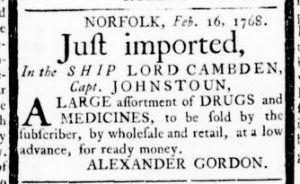What was advertised in a colonial American newspaper 250 years ago this week?

In the second edition of the Virginia Gazette published in 1773, Alexander Purdie and John Dixon, the printers, inserted a notice addressed to “CUSTOMERS who have never paid a Farthing since the Commencement of our Partnership (very near Seven Years).” They made the usual sorts of threats that printers throughout the colonies made when they found themselves in similar situations. They vowed not to deliver any more newspapers to those recalcitrant subscribers. In addition, those who did not settle accounts “before the ensuing April General Court” could expect that they “will be put in the Hands of an Attorney to bring Suit.” Other customers had also neglected to pay their bills, including some who “have owed us a great Deal too long for BOOKS and STATIONARY.” They would receive “the same Treatment, if they do not pay in a very short Time.”
The printers did not mention whether they previously extended credit to advertisers who also neglected to make payments. Many printers required advertisers to pay in advance, but not all did so. A note that Purdie and Dixon added at the end of their notice indicated that, no matter their policy in the past, certain advertisers had to submit payment along with any advertising copy directed to the printers. “ADVERTISEMENTS coming to this Office from any other those with whom we have Accounts,” the printers advised, “unless the NEEDFUL accompanies them, will be paid no Regard to.” In other words, prospective advertisers had to send payment or else Purdie and Dixon would not print their notices. The colophon specified that advertisements “of a moderate Length” cost three shilling for the first week, covering the cost of setting type as well as the amount of space they occupied, and another two shillings for each additional insertion. Given that subscriptions cost twelve shillings and six pence per year, Purdie and Dixon may have been able to wait seven years for some subscribers to pay their bills because they collected payment for most advertisements before publishing them. In such an instance, advertising accounted for a more significant revenue stream than subscriptions.











